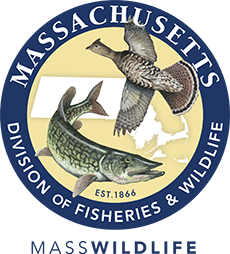- Division of Fisheries and Wildlife
Media Contact
Media Contact, MassWildlife

March in New England often feels like an extension of winter. But if you look (and listen) closely, you may observe the subtle, but unmistakable signs of spring—like the mating flight of the American woodcock. This courtship display, also known as the “sky dance,” is a remarkable aerial performance conducted during the woodcock breeding season which begins in March.
Meet the sky dancers
The American woodcock (Scolopax minor)—also known as timberdoodle, bogsucker, and Labrador twister—is a plump, short-legged bird with a long straight bill. The unique physical features and behaviors of this forest-dwelling sandpiper have earned the woodcock a rather quirky reputation and certainly inspire wonder in those who see them.
Woodcocks can be found in forest edges, young forests, and overgrown fields in poorly drained areas with moist soil. The mottled brown, tan, and gray of their feathers provide excellent camouflage to these birds as they move along the leaf-covered ground searching for food. Their long, flexible bill helps the woodcock probe soft soil for earthworms and other invertebrates. While searching for food, woodcocks sometimes rock from front to back shifting their weight from foot to foot while their head stays still. This peculiar-looking “boogie walk” is thought to create vibrations that help the woodcock locate earthworms. Their large eyes are set relatively far back on the head and help the woodcock keep watch for predators while probing the ground for a meal.
The big show
The American woodcock is native to eastern US and Canada and migrate relatively short distances seasonally. They can be found throughout Massachusetts from early spring through the fall; mating season begins in early or mid-March and lasts through May.
To attract females and establish their territory, males perform a complex set of vocal and physical maneuvers to show their fitness:
- In an open or semi-open field near a forested area, the American woodcock claims a section of the ground and repetitively make a nasal “peent” call. This sound helps attract females and alerts rival males of their presence.
- After a series of peent calls, the woodcock suddenly takes to the air in a wide spiraling flight pattern. As they fly to heights of about 200-300 feet, males beat specialized wing feathers to produce a steady twittering or whistling sound.
- At the height of their flight, the woodcock hovers in preparation for the descent. The twittering pulses get shorter and may include a few louder sharp chirps.
- During the descent, the woodcock flies in a zigzagging, fluttering motion. They may also produce a series of liquid chirping sounds (that could be made by vocalizations or wing beats—biologists are still debating!).
- Finally, the male woodcock lands silently near its original position and waits to see if a female has noticed. This performance may be repeated several times while the glow of twilight lasts.
How to view
The American woodcock breeds in all counties of the Commonwealth. If you’d like to witness the sky dance, here are some tips to increase your chances for seeing or hearing the woodcock mating display:
- Time of year: Woodcock typically arrive in Massachusetts by mid-March and breed from then through late May.
- Time of day: Males perform their mating flight during twilight, when there is some light in the sky after sunset or before sunrise. If you venture out at dusk, find a spot to sit on the eastern edge of the signing grounds so that you can see the birds with the remaining light in the west.
- Habitat: While American woodcocks spend majority of their time in forested areas, mating displays occur in open habitats including overgrown pastures and orchards, brushy fields, or bogs. Displays may even take place in utility rights of way or city parks that are near forests.
When viewing woodcock displays or any wildlife, make sure to give these birds plenty of space so you don’t disrupt their natural behavior. Stay at the edge of the singing grounds and position yourself lower to the ground using vegetation to disguise your presence.
If you miss out on seeing a woodcock display this spring, check out one of the many online videos. Do you have footage of a sky dance? Send it to MassWildlife on Facebook, Instagram, or by email.


